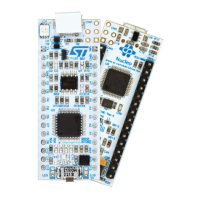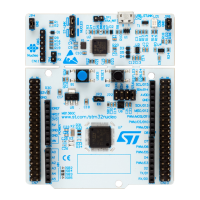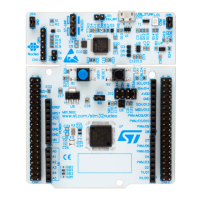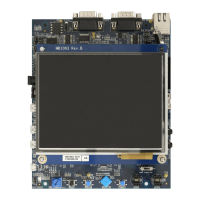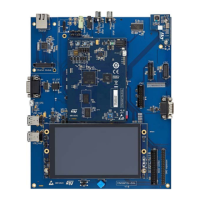Hardware layout and configuration UM1724
20/68 UM1724 Rev 14
6.3 Power supply and power selection
The power supply is provided either by the host PC through the USB cable, or by an
external source: VIN (From 7
V to 12 V), E5V (5 V) or +3.3V power supply pins on CN6 or
CN7. In case VIN, E5V or +3.3V is used to power the STM32 Nucleo board, using an
external power supply unit or auxiliary equipment, this power source must comply with the
standard EN-60950-1: 2006+A11/2009, and must be Safety Extra Low Voltage (SELV) with
limited power capability.
6.3.1 Power supply input from the USB connector
The ST-LINK/V2-1 supports USB power management allowing to request more than
100
mA current to the host PC.
All parts of the STM32 Nucleo board and shield can be powered from the ST-LINK USB
connector CN1 (U5V or VBUS). Note that only the ST-LINK part is power supplied before
the USB enumeration as the host PC only provides 100
mA to the board at that time. During
the USB enumeration, the STM32 Nucleo board requires 300
mA of current to the host PC.
If the host is able to provide the required power, the targeted STM32 microcontroller is
powered and the red LED LD3 is turned ON, thus the STM32 Nucleo board and its shield
can consume a maximum of 300
mA current, not more. If the host is not able to provide the
required current, the targeted STM32 microcontroller and the MCU part including the
extension board are not power supplied. As a consequence, the red LED LD3 remains
turned OFF. In such a case it is mandatory to use an external power supply as explained in
the next
Section 6.3.2: External power supply inputs: VIN and E5V.
When the board is power supplied by USB (U5V) a jumper must be connected between pin
1 and pin 2 of JP5 as shown in
Table 8.
JP1 is configured according to the maximum current consumption of the board when
powered by USB (U5V). JP1 jumper can be set in case the board is powered by USB and
maximum current consumption on U5V does not exceed 100
mA (including an eventual
extension board or ARDUINO
®
shield). In such a condition, USB enumeration always
succeeds since no more than 100
mA is requested to the PC. Possible configurations of
JP1 are summarized in
Table 6.
Warning: If the maximum current consumption of the NUCLEO and its
extension boards exceeds 300 mA, it is mandatory to power
the NUCLEO using an external power supply connected to
E5V or VIN.
Note: In case the board is powered by a USB charger, there is no USB enumeration, so the led
LD3 remains set to OFF permanently and the target STM32 is not powered. In this specific
case, the jumper JP1 needs to be set to ON, to allow target STM32 to be powered anyway.
Table 6. JP1 configuration table
Jumper state Power supply Allowed current
JP1 jumper OFF
USB power through CN1
300 mA max
JP1 jumper ON 100 mA max

